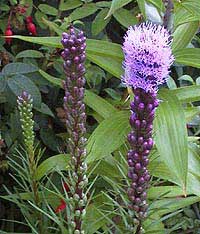Liatris spicata 'Kobold' and L. spicata 'Floristan White'
GAYFEATHER, BLAZING STAR, BUTTON SNAKE ROOT, SNAKE ROOT
Family: Asteraceae
Quick Jumps
Growing Guide
Rainy Side Notes
GROWING GUIDE

Origin:
East and South United States.
Plant Group:
Perennial.
Hardiness:
Sunset zones 1-10, 14-24.
USDA zones: 4-9.
Mature size:
Height: 'Kobold' - 2 feet (60 cm) 'Floristan White' - 3 feet (91 cm).
Width: 18 inches (45 cm).
Flowering period:
Late summer to early fall.
Flowering attributes:
Spikes of purple flower heads ('Kobold') or white ('Floristan White'). The blossoms make a great cut flower.
Leaf attributes:
Linear-lance-shaped leaves.
Light:
Full sun.
Soil:
Moist, fertile, well-drained soil.
Feeding:
Side dress with compost and fertilize with complete organic fertilizer in spring.
Propagation Methods:
Sow at 68ºF (20ºC) in autumn and place in cold frame.
Divide in spring.
Pruning Methods:
No pruning is needed. When cutting flowers be sure to leave enough foliage and stem to sustain the plant.
Rainy Side Notes


I first learned about this plant from a florist friend, many years ago. She grew them for her flower arrangements. I introduced them to my garden at that time and can't imagine my garden without them. I was intrigued with how liatris blooms start at the top of the stem and work their way down. My friend showed me how you could cut the spent flowers from the top and it would continue to bloom down the stem. This attribute makes it a perfect cut flower that will last long in the vase. Helianthus (sunflowers) and liatris in a vase make a wonderful bouquet of contrasting colors.
You can dry liatris by harvesting the flower spikes when one-half to two-thirds of the flowers are open. Remove foliage from the stems; then hang them upside down in a dark, dry place. Good air circulation is important to prevent molding. If you use a fan the drying process takes approximately three weeks. Using desiccants such as silica-gel or sand, it will give flowers a truer blossom color.
The species, Liatris spicata, normally occurs on stream banks and ditch sides so it can tolerate a moister soil, making it a good variety for our maritime Pacific Northwest climate. Other species of liatris require very dry soils making them more difficult to grow with our wet winters. These have proven to be very easy-care plants, and they are pest and disease free in my garden. Divide them every few years to increase your stock and keep plants vigorous. Cut the tuberous roots with a sharp knife and allow at least one eye to remain on each division.
My colonies politely reseed themselves around the garden. If I don't cut the seed heads off, sometimes in late winter I can see little plants growing from the seeds still lingering on the flower stalk. This American native is an excellent bee and butterfly plant.
Photographed in author's garden.

Gardening for the Homebrewer: Grow and Process Plants for Making Beer, Wine, Gruit, Cider, Perry, and More
By co-authors Debbie Teashon (Rainy Side Gardeners) and Wendy Tweton
Copyright Notice | Home | Search | Bulbs

